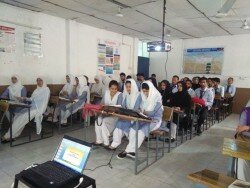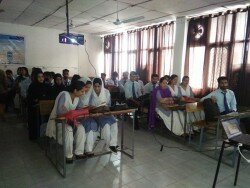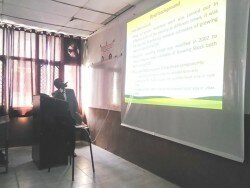FOREST INVENTORY AND CARBON ESTIMATION
Event Description
Intoduction:
As a part of academic activity, a guest lecture was organized by Botany Department on 9 March 2017. Students from the Department of Botany, and Environmental Sciences attended the guest lecture by Mr. N.K. Bhatia fro Forest Survey of India, Dehradun. The lecture was started 11am in the morning and continued till 12:30pm in the noon. The lecture was easy, understandable, and knowledgeable in all the respect. The lecture covered the basic concept of forest inventerization, methods involved and about carbon sequestration. He covered the working methods of Forest Survey of India and how forest cover of the country is assessed.
About the Guest Speaker:
Mr. Narendra Kumar Bhatia has 40+ years working experience in State/Central Govt. institutes affiliated with Ministry of Environment and Forests. He has wide knowledge of data processing on main-frame computers and statistical analysis of forest resources related data. He is actively involved in many centrally sponsored Schemes/projects of Govt. of India
Career Achievements:
(i) Attended training on “Forest Canopy Density Assessment “jointly organized by IIRS and JOFCA (Japan).
(ii) Attended international training course in Sweden on “National Forest and Landscape Inventory and Monitoring at Swedish University of Agriculture Sciences, SLU,Ume
(iii) Attended “SAARC Training Workshop on Measurement and Estimation of Forest Carbon Stock”.
(iv)Participated “Indo-US Forest Inventory, Monitoring and Carbon Methods, Tools and Technologies Workshop”.
(v) Research Paper published in “Indian Forester and other reputed Journals.
Work Places: Delhi, Dehradun, Tehri and Lucknow
Current Position:
Working as Technical Officer in ‘Technical Cooperation Programme’ of FAO, United Nations/Govt.of India project titled “Strengthening National Forest Inventory and Monitoring Protocols and Capacities in India”.
About the Lecture : During the lecture Mr. Bhatia gave brief background of Forest survey of India, Forest inventory and its goals, National Forest Inventory, sample collection, carbon estimation etc. the main highlights of the lecture were:
- Brief Background of FSI– Field inventory of unexplored forest areas started after launch of a FAO/UNDP/GOI project named as Pre-Investment Survey of Forest Resources (PISFR) in 1965 which led foundation of NFI. Forest Inventory confined to certain project areas for setting up wood based industries. PISFR was renamed as FSI, a fully Govt of India organization in 1981.
- Goals of Forest Inventory-which includes producing qualitative and quantitative statistics about forest, area estimation, growing stock estimation.
- Sampling design for forest inventory- The sampling design is two-stage stratified sampling.
- Data collection crew- Data Collection is done by the trained technical staff of FSI’s zonal offices at Shimla, Bangalore, Kolkata and Nagpur.
- Accuracy of methodology- Precision of estimate: The results of the survey would be at the precision limit of ± 5% at 95% probability level, which will be obtained for the national estimates.
- Data entry and processing: Data is checked manually and entered into the computer using a data entry module developed by FSI. The entered data sent to FSI Dehradun for processing.The data is again checked using computer based programs and cleaned. The clean data is processed using data processing module developed by FSI. Use of the suitable volume equation is most critical for precisely estimating the volume/(biomass) of the trees.
- Role of Forest in Carbon sequestration– Forest play important role in carbon sequestration. By the loss of forest, the capacity to extract GHG from the atmosphere is lost and vast quantities of carbon currently locked in forest are made available for release into atmosphere.
- Global Climate Change Indications– Average temperature increased by 0.74ºC between. Sea level rise of 20 cm in last century. GHG emission up by 70% between . Reduction in snow cover by 10% since 1960
- Impact of Climate Change– Impacts are worst
Hotter summers, colder winters, floods and droughts
Shortage of food, clean water and other resources in the poorest countries
In forests, loss of biodiversity: approx. 20-30% species at risk if warming exceeds 1.5-2.5ºC
Natural disturbances such as forest fires
Conclusion:
Mr. Bhatia through his experience, knowledge and easy lecture was able to gain the student’s attention. The lecture was beneficial for the students and was attended by the students with full interest. The practical aspect of working of FSI which he discussed was very exciting and valuable for the students.




